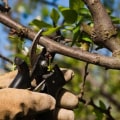How to Make a Tree Healthy Again Plant the Right Tree in the Right Place. Choose a tree designed for your area, then find a place that receives enough sun and provides enough space for its fully grown crown. Trees need to prune dead, dying and weak branches and branches to achieve maximum health and beauty. If left, dead branches can attract pests and diseases that can damage your tree and the trees around it.
One of the joys of living in the countryside is to be surrounded by large and wonderful trees. Not only do they add shade and beauty, but they also greatly increase the value of your property. Replacing even a small tree can cost hundreds of dollars. So it only makes sense to protect your investment and nurture the trees so that they can be appreciated for generations.
Here are 10 tips for keeping your trees healthy. So whether you're installing a driveway or building a shed, take a moment to discuss tree protection with any contractor and specify where heavy equipment can go and can't go. It is better to mark areas around trees during construction. Stake areas that are at least 10 feet from the drip line of the tree, that is, as far as the branches of the tree extend.
A good indicator of the good health of trees is the appearance of the leaves. Make sure the leaves on the tree have the right shade of color for the season. In most deciduous trees, this means green leaves in spring and summer, and yellow, orange, or red leaves in autumn. In evergreen trees, green needles all year round are a healthy sign.
Living things need to eat rich and nutritious food to grow and be healthy. Like humans, trees and plants require essential nutrients to survive and thrive. When a tree has too much or too little nutrition, it weakens and becomes vulnerable to pests and diseases. Trees absorb their food through the soil, in addition to needing moisture and sunlight.
While trees planted in the past three or four years benefit from additional fertilization and watering, large trees can be damaged by fertilizer and excess water. In the arid west, new homeowners who install spraying systems often begin to water trees that are used to dry conditions, soaking the soil and depriving them of the oxygen they are used to. If a new tree cannot stand on its own, use a system of two stakes (one on each side of the root ball) with a loose, flexible loop in the middle to support the trunk. Your trees have the ability to take care of themselves and often require little intervention on your part.
They can also be damaged by the application of herbicides on the lawn and garden, another good reason to place that large circle of mulch so as not to pour chemicals on at least a part of the roots of the tree. Young trees are particularly susceptible, but can be protected with plastic wraps available in nurseries and garden centers. Newly transplanted trees need more care and attention than older, more established trees, as they can suffer transplant shock. It is important to mulch the base of trees (with the exception of trees in a forest).
For more information on tree pests and control measures, visit the Bayer Advanced tree care 101 website. If you have an evergreen tree such as pine, fir or hemlock, be careful of sections of the tree that are bare or needle-free. Water deeply to saturate the entire root zone (2-3 feet deep for mature trees) to just outside the drip line (an imaginary line from the outside of the treetop to ground level). Soil injected fertilizers for established trees offer more controlled and accurate dosing of trees than pellets.
Mulch will not only protect your tree from lawn equipment, but will also remove weeds and keep moisture in the soil. .





